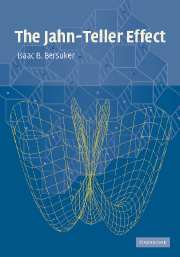Book contents
- Frontmatter
- Contents
- Preface
- Abbreviations
- 1 Introduction
- 2 Vibronic interactions
- 3 Formulation of Jahn–Teller problems. Adiabatic potentials
- 4 Pseudo Jahn–Teller, product Jahn–Teller, and Renner–Teller effects
- 5 Solutions of vibronic equations. Energy spectra and JT dynamics
- 6 The JTE in spectroscopy: general theory
- 7 Geometry, spectra, and reactivity of molecular systems
- 8 Solid-state problems: local properties and cooperative phenomena
- Appendix
- Subject index
- Formula index
3 - Formulation of Jahn–Teller problems. Adiabatic potentials
Published online by Cambridge University Press: 07 December 2009
- Frontmatter
- Contents
- Preface
- Abbreviations
- 1 Introduction
- 2 Vibronic interactions
- 3 Formulation of Jahn–Teller problems. Adiabatic potentials
- 4 Pseudo Jahn–Teller, product Jahn–Teller, and Renner–Teller effects
- 5 Solutions of vibronic equations. Energy spectra and JT dynamics
- 6 The JTE in spectroscopy: general theory
- 7 Geometry, spectra, and reactivity of molecular systems
- 8 Solid-state problems: local properties and cooperative phenomena
- Appendix
- Subject index
- Formula index
Summary
This chapter is to formulate in general the different “traditional” situations that occur due to the lack of minimum of the APES in systems with degenerate electronic terms, as predicted by the JT theorem (Section 2.5). They are labeled as JT problems. Each of them is characterized by the type of degenerate electronic term Γ and the JT-active vibrational modes γi (denoted as the Γ ⊗ (γ1 + γ2 + ···) problem), and has a specific APES. The latter is most important to the solution of the vibronic coupling equations (2.6), which yield the energies and wavefunctions considered in Chapter 5. But the APES has also independent value, allowing qualitative and semiquantitative evaluation of important properties of the system. Other (less traditional) situations including PJT, RT, and product JT problems are formulated in Chapter 4.
Basic formulation. The simplest (E ⊗ b1) and E ⊗ (b1 + b2) problems
The JT problems refer to polyatomic (molecular and crystalline) systems with degenerate electronic states, for which the JT theorem is operative. As follows from group-theoretical considerations, degenerate states may occur in systems with high symmetry that have at least one rotational or rotoflection axis of the order n > 2. The higher the symmetry, the more and higher-order degenerate terms are possible. Systems with axial symmetry have twofold degenerate E terms, cubic systems have E and threefold degenerate T terms (with spin–orbital interaction included they may have also fourfold degenerate G terms), while icosahedral systems have E, T, G, and fivefold degenerate H terms (see the corresponding point groups in the appendix).
- Type
- Chapter
- Information
- The Jahn-Teller Effect , pp. 45 - 109Publisher: Cambridge University PressPrint publication year: 2006



